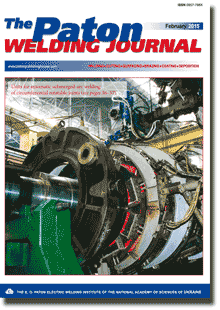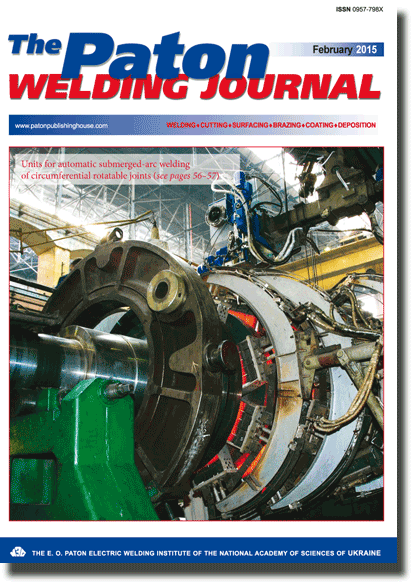| 2015 №02 (03) |
DOI of Article 10.15407/tpwj2015.02.04 |
2015 №02 (05) |

The Paton Welding Journal, 2015, #2, 19-25 pages
UPERSONIC PLASMA GAS AIR SPRAYING OF CERMET COATINGS OF THE (Ti, Cr)C-NiCr SYSTEM
Yu.S. Borisov, A.L. Borisova, M.V. Kolomytsev And O.P. Masyuchok
E.O. Paton Electric Welding Institute, NASU. 11 Bozhenko Str., 03680, Kiev, Ukraine. E-mail: office@paton.kiev.ua
Abstract
Effect of plasma gas air spraying (PGAS) factors (plasmatron power, consumption of plasma gas, spraying distance, anode diameter) of mechanical mixture from double titanium-chromium carbide and nichrome powders on characteristics of produced coatings (structure, microhardness, porosity, chipping resistance) was investigated. Program of experiments was composed using mathematical planning method. Regression equations, determining quantitative dependence of values of average and maximum microhardness, stability of microhardness indices and level of chipping on spraying process factors, were received based on data processing results. Indices of heat content in plasma jet and duration of powder particle passing through plasma jet were used for analysis of the results. It is determined that mode of plasma jet outflow and value of its heat content have the largest effect on structure and properties of produced coatings. Using 10 mm diameter anode, providing supersonic jet outflow mode at 5.6 kWрh/m3 heat content index, for PGAS of coatings from mechanical mixture of titanium-chromium carbide and nichrome powders (3:1) promotes for formation of dense coatings (porosity <1 %) with cermet structure (titanium-chromium carbide and nichrome). Such coatings have average microhardness 12.6 GPa that 1.5 times exceeds microhardness of thermal coatings from mechanical mixture of chromium carbide and nichrome powders (8.6 GPa). 20 Ref., 6 Tables, 2 Figures.
Keywords: cermets, double titanium-chromium carbide, supersonic plasma gas air spraying, coating properties, microhardness, experiment planning
Received: 21.11.14
Published: 01.04.15
References
1. Borisov, Yu.S., Borisova, A.L. (1986) Plasma powder coatings. Kiev: Tekhnika.
2. Borisov, Yu.S., Kharlamov, Yu.A., Sidorenko, S.L. et al. (1987) Thermal coatings from powder materials: Refer. Book. Kiev: Naukova Dumka.
3. Toma, D., Brandtt, W., Marginean, G. (2001) Wear and corrosion of thermoalloy sprayed cermet coatings. Surface and Coatings Technology, 138, 149-158. https://doi.org/10.1016/S0257-8972(00)01141-5
4. Espallargas, N., Berget, J., Guilemany, J.M. et al. (2008) Cr3C2-NiCr and WC-Ni spray coatings as alternatives to hard chromium for erosion-corrosion resistance. Ibid., 202, 1405-1417. https://doi.org/10.1016/j.surfcoat.2007.06.048
5. Fedrizzi, L., Rossi, S., Cristel, R. et al. (2004) Corrosion and wear behavior of HVOF cermet coatings used to replace hard chromium. Electrochimica Acta, 49, 2803-2814. https://doi.org/10.1016/j.electacta.2004.01.043
6. Guilemany, J.M., Espallargas, N., Suegama, P.H. et al. (2006) Comparative study of Cr3C2-NiCr coatings obtained by HVOF and hard chromium coatings. Corrosion Sci., 48, 2998-3013. https://doi.org/10.1016/j.corsci.2005.10.016
7. Sahoo, P., Raghuraman, R. (1993) High temperature chromium carbides reinforced metal matrix composite coatings for turbomachinery application. In: Proc. of Thermal Spray Conf. (Aachen, Germany, 1993), 296-300.
8. Takeuchi, J., Nakahira, A. (1993) Cr3C2-NiCr cermet coatings using some HVOF, APS and UPS process. Ibid., 11-14.
9. Beczkowiak, J., Fisher, J., Schwier, Y. (1993) Cermet materials for HVOF processes. Ibid., 32-36.
10. (2000) Powder solutions catalog. In: Praxair Surface Technologies.
11. (2011) Thermal spray materials. In: Sulzer Metco Guide.
12. Keller, H., Pross, E., Schwier, G. (2000) Influence of the powder type on the structure and the properties of chromium carbide. In: H.C. Starck Nickel, Chromium Alloys. Specialist for Specialties.
13. Vojtovich, R.F., Pugach, E.A. (1973) Peculiarities of high temperature oxidation of carbides of VI group transition metals. Poroshk. Metallurgiya, 4, 59-64.
14. Gorbatov, I.N., Ilchenko, N.S., Terentiev, A.E. et al. (1991) Effect of cladding of double Ti-Cr carbide on properties of plasma coatings. Fiz.-Khimich. Obrab. Materialov, 3, 81-85.
15. Gorbatov, I.N., Shkiro, V.M., Terentiev, A.E. et al. (1991) Examination of properties of thermal coatings from composite powders of nickel-titanium and chromium carbide. Ibid., 4, 102-106.
16. Gorbatov, I.N., Panasyuk, A.D., Shvedova, L.K. et al. (1991) Thermal coatings on the base of titanium-chromium carbide. Zashch. Pokrytiya na Metallakh, Issue 25, 22-25.
17. Borisova, A.L., Chernets, A.I. (1993) Phase and structural transformations in powders of pure clad double titanium-chromium carbide in plasma jet. Problemy Spets. Elektrometallurgii, 3, 63-72.
18. Rajtses, V.B., Litvin, V.M., Rutberg, V.P. et al. (1986) Wear-resistant plasma coatings based on Ti-Cr double carbide. Poroshk. Metallurgiya, 10, 46-47.
19. Borisov, Yu.S., Petrov, S.V. (1993) Application of supersonic jets in technology of thermal spraying. Avtomatich. Svarka, 1, 24-34.
20. Borisov, Yu.S., Fishman, S.L., Yushkov, V.I. et al. (1975) Cermet plasma coatings. In: Inorganic and organic-silicate coatings. Leningrad: Nauka.
Suggested Citation
Yu.S. Borisov, A.L. Borisova, M.V. Kolomytsev And O.P. Masyuchok (2015) Upersonic plasma gas air spraying of cermet coatings of the (Ti, Cr)C-NiCr system. The Paton Welding J., 02, 19-25.The cost of subscription/purchase order journals or individual articles
| Journal/Currency | Annual Set | 1 issue printed |
1 issue |
one article |
| TPWJ/USD | 384 $ | 32 $ | 26 $ | 13 $ |
| TPWJ/EUR | 348 € | 29 € | 24 € | 12 € |
| TPWJ/UAH | 7200 UAH | 600 UAH | 600 UAH | 280 UAH |
| AS/UAH | 1800 UAH | 300 UAH | 300 UAH | 150 UAH |
| AS/USD | 192 $ | 32 $ | 26 $ | 13 $ |
| AS/EUR | 180 € | 30 € | 25 € | 12 € |
| SEM/UAH | 1200 UAH | 300 UAH | 300 UAH | 150 UAH |
| SEM/USD | 128 $ | 32 $ | 26 $ | 13 $ |
| SEM/EUR | 120 € | 30 € | 25 € | 12 € |
| TDNK/UAH | 1200 UAH | 300 UAH | 300 UAH | 150 UAH |
| TDNK/USD | 128 $ | 32 $ | 26 $ | 13 $ |
| TDNK/EUR | 120 € | 30 € | 25 € | 15 € |
AS = «Automatic Welding» - 6 issues per year;
TPWJ = «PATON WELDING JOURNAL» - 12 issues per year;
SEM = «Electrometallurgy Today» - 4 issues per year;
TDNK = «Technical Diagnostics and Non-Destructive Testing» - 4 issues per year.


